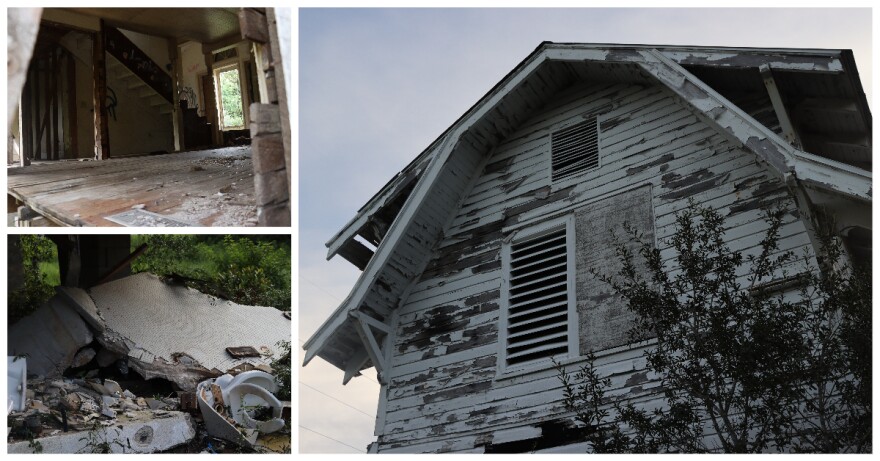Just north of Highway 98 in Wynnehaven Beach is a relic of historical significance most people overlook. The Beal residence, built in 1910, was once the summer home, office, and shell museum of a well-known Fort Walton Beach man. The building now stands vacant.

Dr. James Hartley Beal, born in 1861 in Ohio, was a prominent pharmacist, chemist, scientist, lawyer, and educator. He organized the Scio College of Pharmacy, served as president of Scio College, taught pharmacy at the Pittsburgh College of Pharmacy, and served as editor of the “Midland Druggist.” He also briefly served as president of the American Pharmacists Association from 1904 to 1905.
Support Local Stories. Donate Here.
In 1928, Beal and his family moved to Fort Walton Beach, then known as Camp Walton, and purchased a home. Originally located along the water at 2 Miracle Strip Parkway, the summer home was made almost entirely of hard pine wood.
Although he and his wife resided in a similar style house directly to the east, guests from around the world would stay in the summer home. The building also served as Beal’s office, as well as a place to exhibit his extensive collection of over 2 million shell specimens.



Beal began his shell collection in 1888, when he purchased his first specimen on a trip to Key West. By 1940, his collection had grown to be one of the largest in the world. The collection was eventually donated to Rollins College in Winter Park and later transferred to the Florida Museum of Natural History at the University of Florida.

Each artifact in the collection was tagged with the condition, date, and location it was found, proving to be invaluable to scientists today. Local historian Tom Rice, who owns the Magnolia Grill in Fort Walton Beach, says that some of the specimen vials still have saltwater in them.
“It’s not just a pretty look, it was something that had value,” said Rice. “People came from a lot of places, and [Beal] would lay out his shell collection and people would view it.”
After Beal died in 1945, his family continued to live in the home. The last known person to reside there was Maggie Starkey, aunt of Rice’s wife, Peggy, and granddaughter of Dr. Beal. She lived there until the 1960s.
“We don’t focus on that being the shell museum, that wasn’t really a museum,” Rice said. “That was a residence that had a lot of stuff in it. It really wasn't a shell museum when he was alive, it was his office.”
Rice says that the Beal residence was actually two halves of a house put together. Half of the house was demolished when it was moved from its original location in 2005. Rice also says that some of the windows from the house were used at the former East River Smokehouse in Navarre.
After years of sitting vacant and large-scale renovations, the Beal residence was converted into the Summerhouse Restaurant, which operated from 1988 to 1992 and again from 1995 to 2004. Alan Laird, owner of the AJ’s restaurants, saved the building from demolition in 2005 by moving it to its current location via barge. He planned to turn the building into a restaurant, but due to zoning issues and complaints from nearby residents, those plans never came to fruition.
“It was doomed from the first time he had a hearing,” Rice said.

Despite this, Laird installed a historical marker on the property that talks about Dr. Beal and his shell museum. The house has sat abandoned ever since.
The historical marker has since been removed and the property is now for sale.
“We would just be delighted to see something positive happen to it,” Rice said. “We’ve had our hopes up a couple of times, but the reality is it's living on borrowed time. It would take a tremendous effort and vision for somebody to do something with it.”
Rice spoke of the significance of the house not only to the city of Fort Walton Beach but for that of his family. He says that it’s sad to see the current state of the house.

“The fireplace is kind of a special place for our family,” Rice said. “Members of the family were married there, and you can see it in some of the old 16-millimeter films that my father-in-law had taken on Christmas. When you go by the house now, the chimney has disintegrated and it's just a pile of rubble.”


Through the Lens is a photo essay series from WUWF Public Media. All photos were taken with permission from the property owner. Trespassing on this property is prohibited.
Abandoned Northwest Florida is a photo series that explores forgotten places. Do you know of an abandoned location that should be featured? Email Hunter Morrison at hunter@wuwf.org to let him know.


